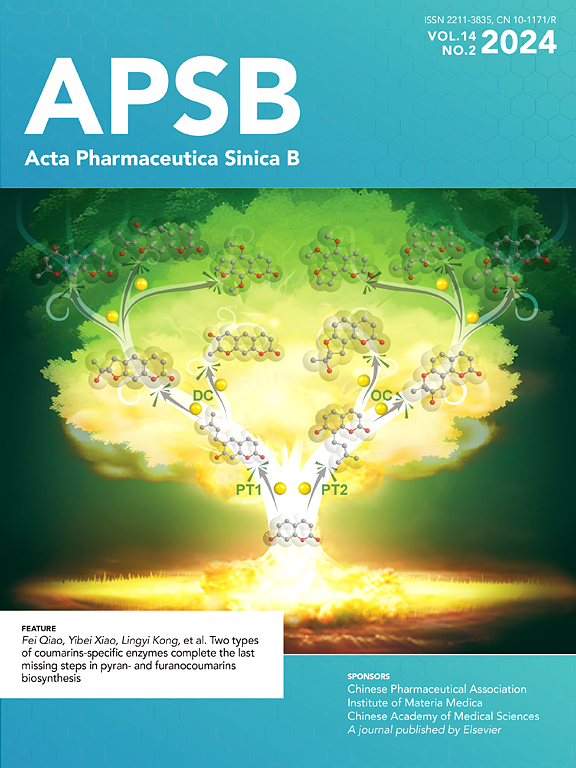通过基于代谢反应的分子网络揭示药物的代谢命运
IF 14.6
1区 医学
Q1 PHARMACOLOGY & PHARMACY
引用次数: 0
摘要
利用液相色谱-质谱(LC-MS)对体内药物代谢物进行有效的注释仍然是一个艰巨的挑战。本文介绍了一种基于代谢反应的分子网络(MRMN)策略,使原型药物及其代谢物的“一锅”发现成为可能。MRMN通过匹配代谢反应和评估MS2光谱相似性来构建网络,并在MS2光谱的特征退化、内生干扰排除和冗余节点识别方面进行了创新和改进。确保了结构相似性和相邻代谢物MS2相似性之间至少75%的相关性,从而减少了由于光谱特征退化而导致的假阴性。与全球天然产物社会分子网络(GNPS)平台相比,至少79%的节点、49%的边和97%的子网络通过内生离子的排除策略减少。此外,改进了一种冗余离子识别方法,对不同样品的识别率达到10% ~ 40%。通过单一化合物、植物提取物和多种植物提取物的混合物验证了MRMN的有效性。值得注意的是,MRMN可以免费在线访问https://yaolab.network,从而扩大了其应用范围。本文章由计算机程序翻译,如有差异,请以英文原文为准。

Unveiling the metabolic fate of drugs through metabolic reaction-based molecular networking
Effective annotation of in vivo drug metabolites using liquid chromatography-mass spectrometry (LC–MS) remains a formidable challenge. Herein, a metabolic reaction-based molecular networking (MRMN) strategy is introduced, which enables the “one-pot” discovery of prototype drugs and their metabolites. MRMN constructs networks by matching metabolic reactions and evaluating MS2 spectral similarity, incorporating innovations and improvements in feature degradation of MS2 spectra, exclusion of endogenous interference, and recognition of redundant nodes. A minimum 75% correlation between structural similarity and MS2 similarity of neighboring metabolites was ensured, mitigating false negatives due to spectral feature degradation. At least 79% of nodes, 49% of edges, and 97% of subnetworks were reduced by an exclusion strategy of endogenous ions compared to the Global Natural Products Social Molecular Networking (GNPS) platform. Furthermore, an approach of redundant ions identification was refined, achieving a 10%–40% recognition rate across different samples. The effectiveness of MRMN was validated through a single compound, plant extract, and mixtures of multiple plant extracts. Notably, MRMN is freely accessible online at https://yaolab.network, broadening its applications.
求助全文
通过发布文献求助,成功后即可免费获取论文全文。
去求助
来源期刊

Acta Pharmaceutica Sinica. B
Pharmacology, Toxicology and Pharmaceutics-General Pharmacology, Toxicology and Pharmaceutics
CiteScore
22.40
自引率
5.50%
发文量
1051
审稿时长
19 weeks
期刊介绍:
The Journal of the Institute of Materia Medica, Chinese Academy of Medical Sciences, and the Chinese Pharmaceutical Association oversees the peer review process for Acta Pharmaceutica Sinica. B (APSB).
Published monthly in English, APSB is dedicated to disseminating significant original research articles, rapid communications, and high-quality reviews that highlight recent advances across various pharmaceutical sciences domains. These encompass pharmacology, pharmaceutics, medicinal chemistry, natural products, pharmacognosy, pharmaceutical analysis, and pharmacokinetics.
A part of the Acta Pharmaceutica Sinica series, established in 1953 and indexed in prominent databases like Chemical Abstracts, Index Medicus, SciFinder Scholar, Biological Abstracts, International Pharmaceutical Abstracts, Cambridge Scientific Abstracts, and Current Bibliography on Science and Technology, APSB is sponsored by the Institute of Materia Medica, Chinese Academy of Medical Sciences, and the Chinese Pharmaceutical Association. Its production and hosting are facilitated by Elsevier B.V. This collaborative effort ensures APSB's commitment to delivering valuable contributions to the pharmaceutical sciences community.
 求助内容:
求助内容: 应助结果提醒方式:
应助结果提醒方式:


